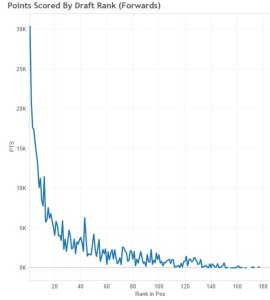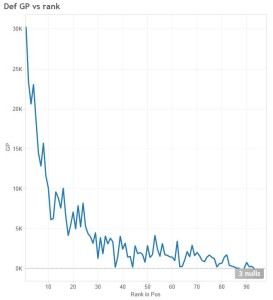At last week’s 2014 Entry Draft, Aaron Ekblad became the first defenseman to go first overall since Erik Johnson in 2006.
Since the NHL began its draft in 1963, only 13 defensemen have been picked first overall. The first was Barry Gibbs in 1966 (and no, he did not later go on to found The Bee Gees). Then in the mid-‘90s defensemen became more popular than a beanie baby, as 4 defensemen were taken first overall in a five year span. Two were taken by Florida teams, as Roman Hamrlik went to Tampa Bay in 1992, and Ed Jovanovski to Florida in 1994. Ottawa then took defensemen in back-to-back drafts when they selected Bryan Berard in 1995 and Chris Phillips in 1996.
Goalies, meanwhile have been drafted first overall only 3 times: Michel Plasse by Montreal in 1967, Rick Di Pietro by the Islanders in 2000, and Marc-Andre Fleury by the Penguins in 2003.
That leaves us with 36 forwards out of 52 first overall picks.
Defensemen and goalies are obviously pretty important to a team’s success, so why do teams picking first predominantly take forwards?
One possibility is that it is relatively easier to predict future performance for forwards. A team might not want to use a first overall pick on a player that has a high chance of not living up to the billing of first overall.
It’s generally accepted that goalies are notoriously hard to forecast in their draft year, and indeed, all 3 goalies selected first overall were relative disappointments. Moreover, last year 7 of the goalies who played the most games for their team were either undrafted or taken in draft rounds so low they no longer exist. So at first glance, goalies really do appear to be a crap shoot.
Perhaps defensemen are similarly hard to predict?
If young forwards are easier to forecast than young defenseman or goalies, then we should see a stronger correlation between the order in which they are picked and some measure of their quality. Finding the right measure of quality is the tricky part.
For forwards we used career points, and for goalies we used save percentage.
Measuring the quality of defensemen is trickier. Some, like P.K. Subban (2nd on the Canadiens in scoring with 53 points last season), make significant offensive contributions, while others, like Marc-Edouard Vlasic (11th on the Sharks with 24 points), show their worth primarily in their own end. Plus, some of the better metrics for all-around play, like Corsi or Fenwick, only go back to 2007-08. So we used total games played.
Note that being drafted earlier is better, so better players should have lower draft numbers. This means that we should see negative correlations between draft position and points, games played and save percentage – all measures for which more is better.
As it turns out, teams have pretty much no ability to forecast the performance of goalies. The correlation coefficient between goalie draft order and save percentage is 0.078, which indicates very little relationship between draft order and save percentage. Even worse news for GMs, to the extent that there is a relationship, it indicates that, on average, the better goalies have been picked later in the draft.
For forwards, we found a correlation coefficient of -0.282. It’s not huge, but at least it’s negative, meaning that the better players are in fact picked earlier in the draft. The results are shown in the chart below, and as you can see, there is a trend, but it’s not a strong one.
For defensemen, the correlation coefficient is -0.25 – slightly weaker than for forwards, but not a huge difference, especially given the weaker measure of quality.
So difficulty in forecasting probably explains why goalies are chosen so rarely, but why aren’t more defensemen taken? When considering who to pick, one important factor is the difference between taking the best player available at the moment versus who is likely to be still available when a team picks next - the idea being that a team might pass on a slightly better defenseman in favor of a forward if an almost equally defenseman is likely to still be available the next time it picks.
That means the difference in performance across the draft order is also a factor. To get a sense of that distribution we looked at the total points produced by forwards and the total games played by defensemen, as a function of the order they were picked.
As the graph shows, the difference in performance among players as the draft progresses is bigger for forwards than defensemen. For forwards, by the time a team’s second round pick comes along, the difference is monumental.
The difference between the first defensemen picked and subsequent ones is also quite large, but not quite on the same scale. Which means that if you’re picking first overall, the difference between who you can get then and who you can get next time around is larger for forwards. And that’s a pretty solid reason to take a forward first.


